Author: Martin Keen
When hops are added to boiling wort, the isomerization of alpha acids contribute sweetness-balancing bitterness while various oils impart desirable aroma and flavor characteristics. Seeing as the lupulin that contains these acids and oils makes up approximately 25% of hops, the additional vegetal material is arguably worthless for brewing purposes and can actually decrease overall yield while creating issues when it comes to transferring the wort out of the kettle, particularly when using a pump.
For these reasons, some brewers prefer to filter their kettle hop additions, which allows the vegetal matter to be easily removed once the boil is complete. While some have claimed this also decreases the chances of the beer having a less desirable grassy note, others believe that filtering hops during the boil limits their contact with the wort, thus reducing their overall contribution to the finished beer.
For the majority of the batches of beer I’ve made over the years, I’ve relied on a stainless mesh filter to contain my hops during the boil, as it was included with the system I brew on. Generally happy with my finished beers, I hadn’t much considered if this tool might be having some negative effect, so the benefit of not having a clogged pump outweighed any risk. However, I recently began to wonder if the claims of some might hold some weight and designed an xBmt to test it out for myself.
| PURPOSE |
To evaluate the differences between an International Pale Lager where the kettle hops were added to a stainless mesh filter and one where they were added directly to the boiling wort.
| METHODS |
For this xBmt, I went with a simple single-hop International Pale Lager recipe in hopes of any differences being easily noticeable.
Polyphony
Recipe Details
| Batch Size | Boil Time | IBU | SRM | Est. OG | Est. FG | ABV |
|---|---|---|---|---|---|---|
| 5.1 gal | 60 min | 22.1 | 4.4 SRM | 1.049 | 1.013 | 4.73 % |
| Actuals | 1.049 | 1.013 | 4.73 % | |||
Fermentables
| Name | Amount | % |
|---|---|---|
| Modern Pilsner | 10.5 lbs | 100 |
Hops
| Name | Amount | Time | Use | Form | Alpha % |
|---|---|---|---|---|---|
| El Dorado | 2 g | 60 min | Boil | Pellet | 13.5 |
| El Dorado | 10 g | 30 min | Boil | Pellet | 13.5 |
| El Dorado | 10 g | 5 min | Boil | Pellet | 13.5 |
Yeast
| Name | Lab | Attenuation | Temperature |
|---|---|---|---|
| Global (L13) | Imperial Yeast | 77% | 46°F - 55.9°F |
Notes
| Water Profile: Ca 62 | Mg 0 | Na 8 | SO4 78 | Cl 54 |
Download
| Download this recipe's BeerXML file |
After collecting the full volume of RO water for two 5 gallon/19 liter batches and adjusting each to my desired profile, I heated them up before incorporating the grains.
Both batches were held at 154°F/68°C for 60 minutes, after which the grains were removed and the worts were boiled for 60 minutes with hops added at the times listed in the recipe, one set going into a stainless hop spider while the other was tossed directly into the wort.
When the boils were complete, I chilled each with my CFC during transfer to sanitized fermenters.
Hydrometer measurements indicated the worts were right around the same target OG.
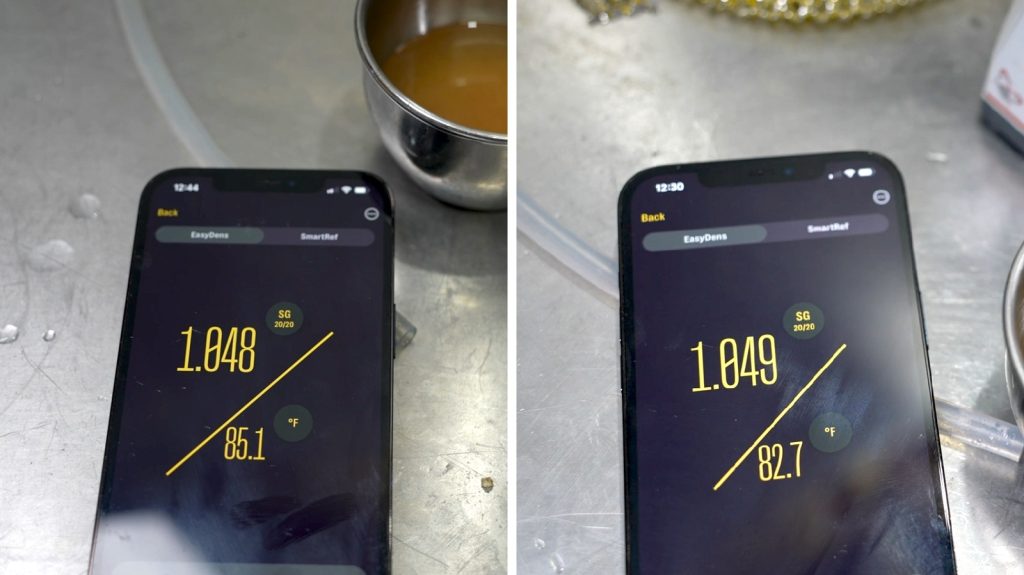
The filled fermenters were attached to my glycol unit and left to finish chilling for an hour before I pitched a pouch of Imperial Yeast L13 Global into each batch.
The beers fermented at 64°F/18°C for 2 weeks before I took hydrometer measurements showing they attenuated similarly.
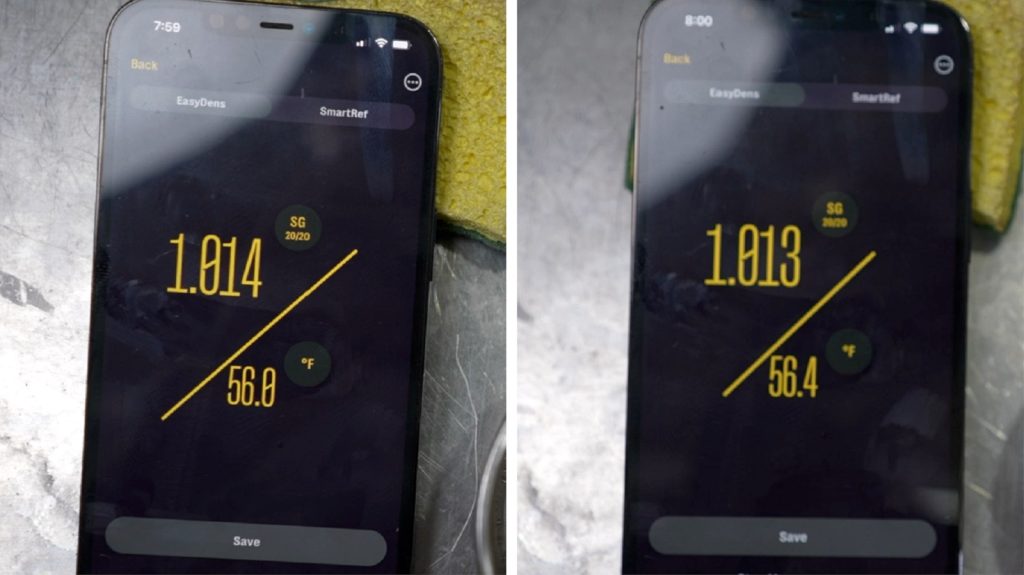
At this point, I cold-crashed the beers to 32°F/0°C for 15 hours before pressure-transferring each to CO2 purged kegs, which were placed on gas in my keezer. After a week of conditioning, the beers were clear, carbonated, and ready to serve to tasters.
| RESULTS |
A total of 20 people of varying levels of experience participated in this xBmt. Each participant was served 1 sample of the beer where the kettle hops were added to a stainless mesh filter and 2 samples of the beer where the hops were added directly to the boiling wort in different colored opaque cups then asked to identify the unique sample. While 11 tasters (p<0.05) would have had to accurately identify the unique sample in order to reach statistical significance, only 7 did (p=0.52), indicating participants in this xBmt were unable to reliably distinguish an International Pale Lager where the kettle hops were added to a stainless mesh filter from one where the kettle hops were added directly to the boiling wort.
My Impressions: Out of the 5 semi-blind triangle tests I attempted, I correctly identified the odd-beer-out just twice. To my palate, these beers were identical, both possessing a light El Dorado hoppiness that balanced the delicate malt flavor with no hint of off-flavors.
| DISCUSSION |
Prior to being used to make to make beer, hops are typically dried, reducing their moisture from around 80% to 10%, which concentrates both the lupulin and the leafy matter. While the prior is the source of what brewers want in their beer, the former is largely unnecessary and is purported by some to impart grassy flavors while complicating transfers, hence the reason some choose to filter their kettle hop additions. Interestingly, tasters in this xBmt were unable to reliably distinguish an International Pale Lager where the kettle hops were added to a stainless mesh filter from one where the kettle hops were added directly to the boiling wort.
International Pale Lager isn’t necessarily a hop-bomb, so one potential explanation for these findings is that the amount of hops added to the boil was simply too low for the filtration to have a perceptible impact. However, this choice was intentional, as tasters in a past xBmt were unable to tell apart an American IPA where the hops were filtered in the boil from one where they were added loosely.
Seeing as I was personally unable to tell these beers apart with any consistency, which aligns with the blind taster data, I’m not convinced using a stainless mesh hop filter during the boil has much if any negative impact. And since I use a brewing system that came with a stainless mesh filter, I have no plans to stop using it, as I appreciate how easy it makes transferring wort through my counterflow chiller into the fermenter, as well as the clean-up convenience.
If you have any thoughts about this xBmt, please do not hesitate to share in the comments section below!
Support Brülosophy In Style!
All designs are available in various colors and sizes on Amazon!
Follow Brülosophy on:
FACEBOOK | TWITTER | INSTAGRAM
If you enjoy this stuff and feel compelled to support Brulosophy.com, please check out the Support page for details on how you can very easily do so. Thanks!


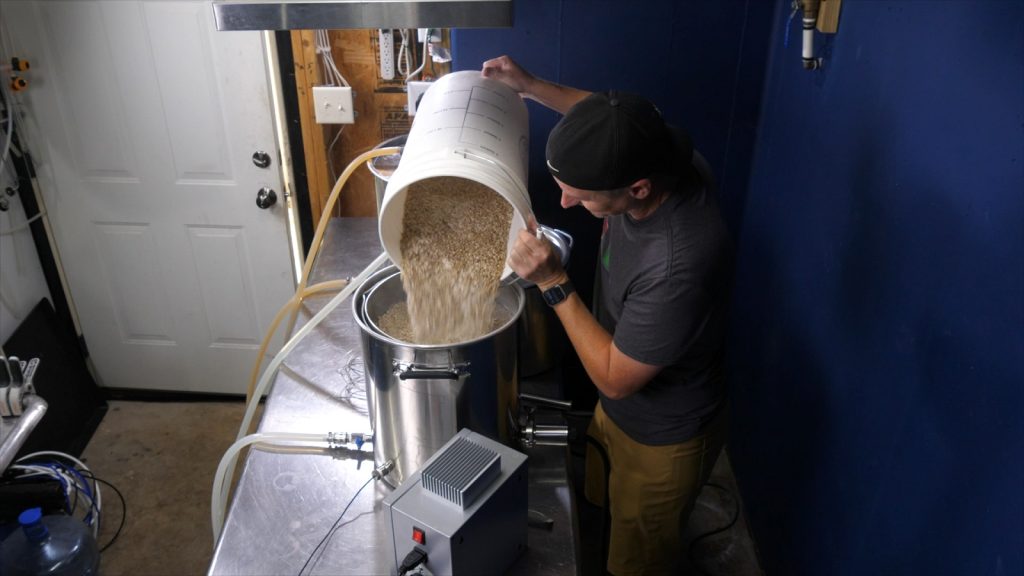
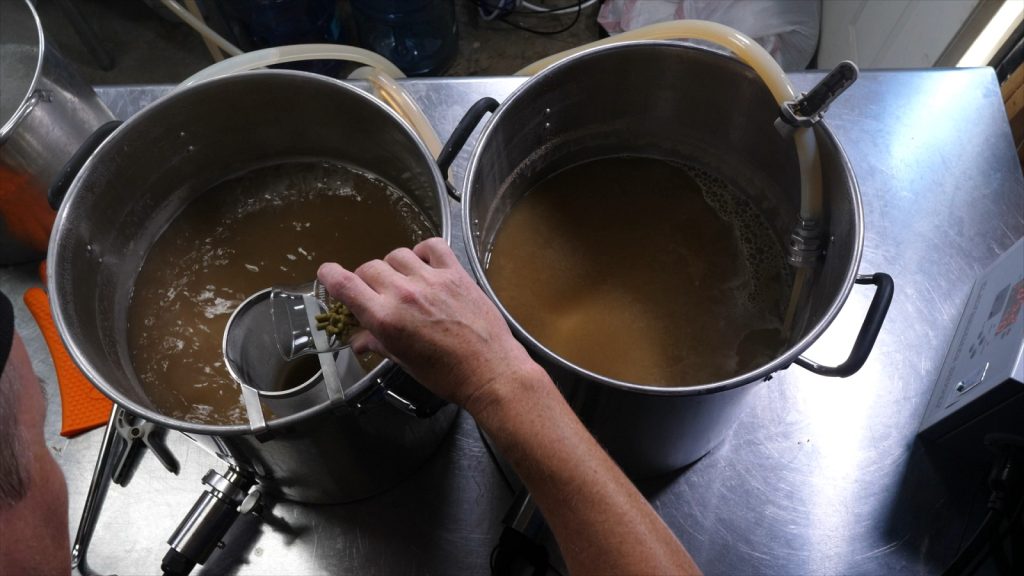
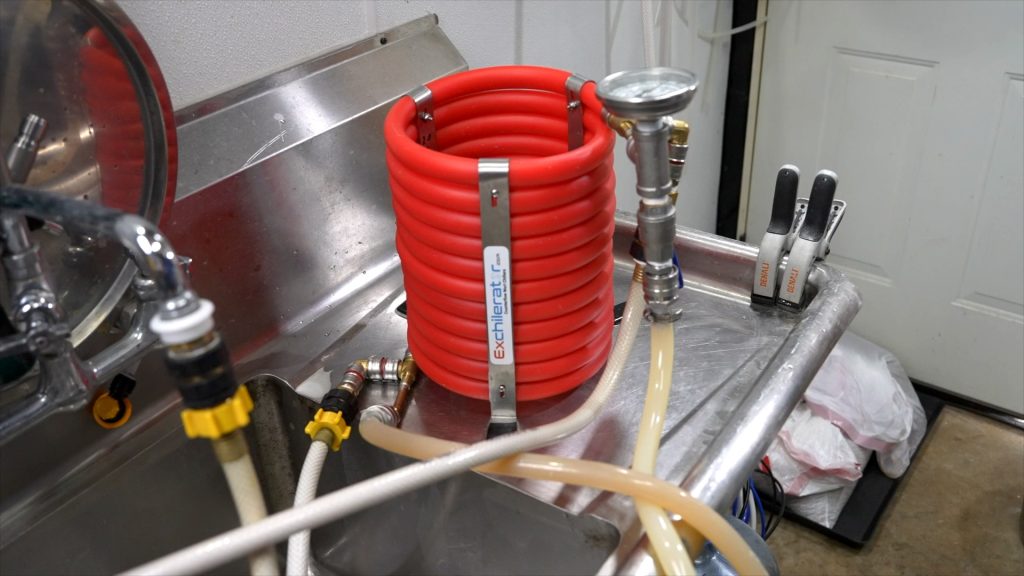
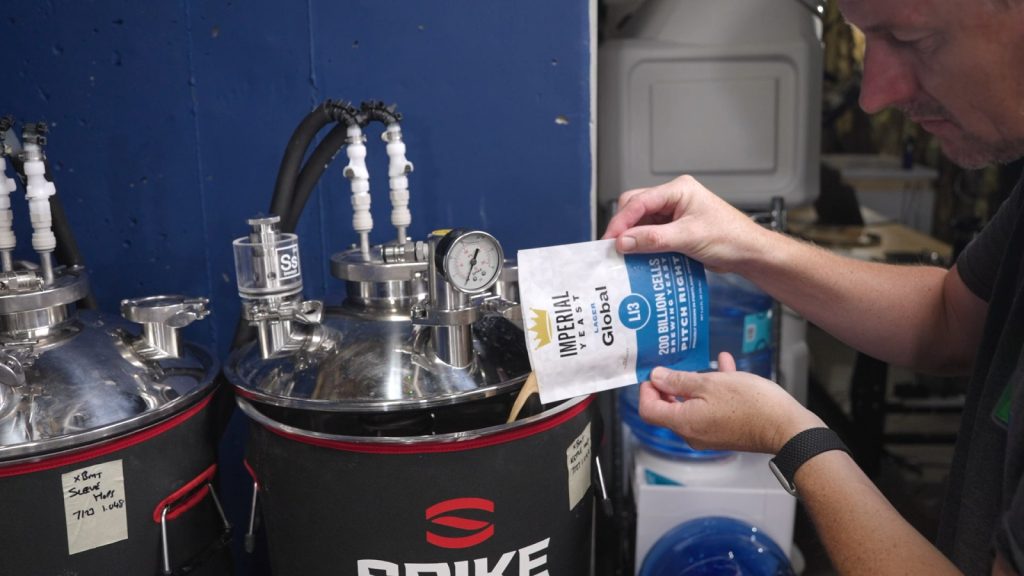
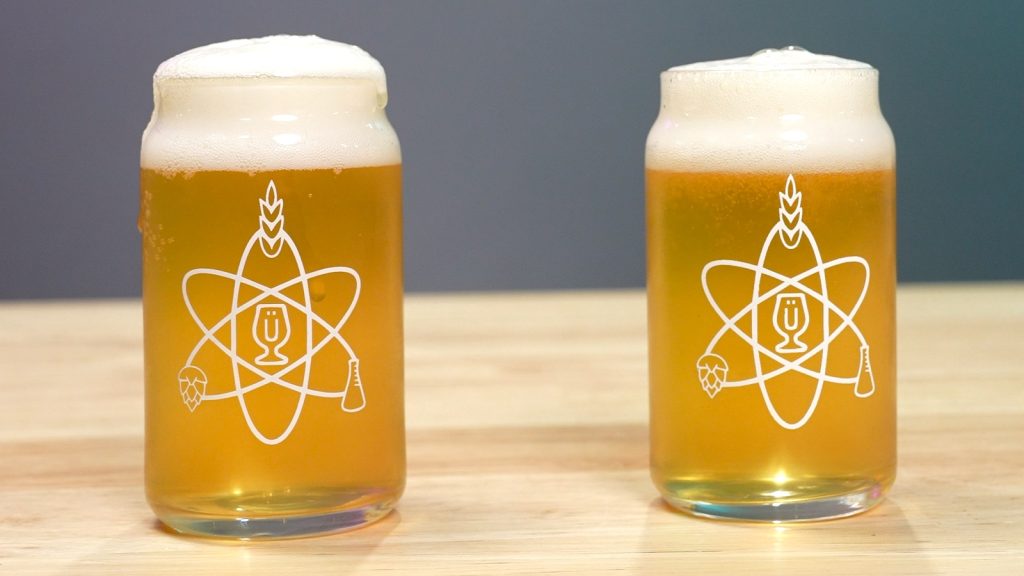











10 thoughts on “exBEERiment | Impact Filtering Kettle Hops With A Stainless Mesh Filter Has On An International Pale Lager”
What is the mesh size of you SS filter? Mine is very fine (400? – the Double Handle Hop Filter – 14 in. x 6 in. at Morebeer) and seems to get clogged very quickly and I’m concerned about the ability to allow the wort to circulate with the hops in the filter. Do you think the mesh size would have an effect provided it’s not a huge amount of hops?
“International Pale Lager isn’t necessarily a hop-bomb, so one potential explanation for these findings is that the amount of hops added to the boil was simply too low for the filtration to have a perceptible impact.”
Ya think!?!?
Why are people so unkind? You blokes do great things for the beer brewing community and I thank you.
Wouldn’t you want the variable to be, you know, more than 22 grams (0.75 ounces) to try and prove there may be some effect?
I came here to say the same. At least go for 1.5oz. Throw in some more FO additions or something.
Love what you do Martin, but this hop addition was so tiny that it is hard to imagine how a hop basket could make any difference. Redo with larger late hop and whirlpool additions?
Looks like you ended up with a pair of cracking beers, Martin.
It’s interesting, but not entirely unexpected, that the results here seemed similar to the previous hop spider exbeeriment – regardless of the significant difference in the volume of hops in the spider.
Have Brulosophy done similar experiments using whole leaf instead of pellets? A less processed hop product, with less surface area, may show a significant result if not allowed to “roam free”.
Although, the amount of whole hops you could fit in a hop spider would probably restrict you to non-hazy styles – which might upset people. Maybe you could use four spiders at once?!
Despite it having been addressed in the article how conducting the experiment in a lower hopped beer was a conscious element of the experiment design (based on the non significant result of the same experiment being conducted in a comparatively heavily hopped IPA), still people queue to have a pop. Similar comments abound in the experiment conducted on the IPA, suggesting ‘of course the variable will be obscured when you’re using so many hops’. Never ceases to amaze.
Interesting read, thanks.
Your hop addition times seem to lean strongly to the bittering effect of hops. I wonder what the results would be like with heavier late additions?
Why not send the beers in for bitterness analysis. That way you will know the difference if any.